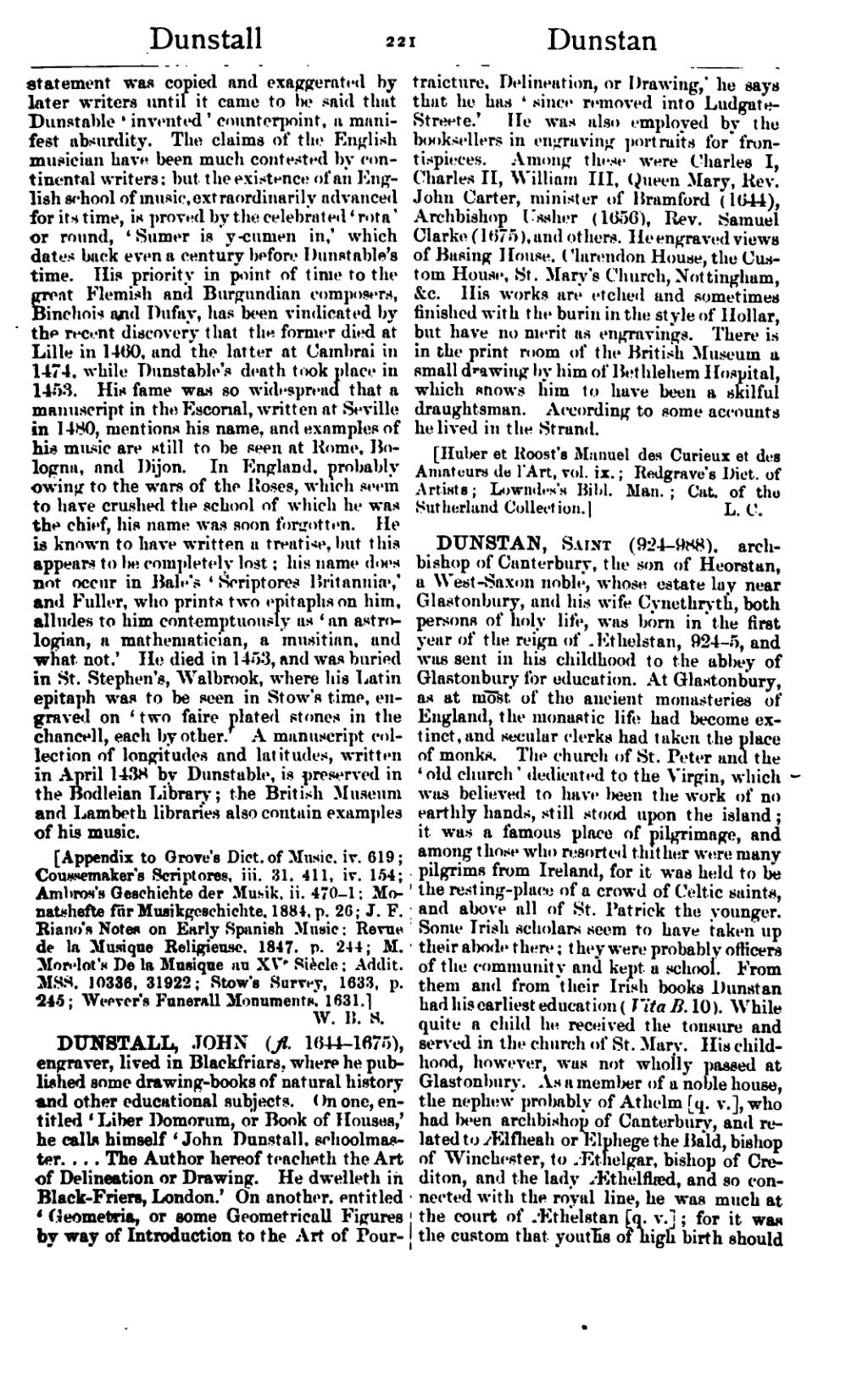statement was copied and exaggerated by later writers until it came to be said that Dunstable ‘invented’ counterpoint, a manifest absurdity. The claims of the English musician have been much contested by continental writers; but the existence of an English school of music, extraordinarily advanced for its time, is proved by the celebrated ‘rota’ or round, ‘Sumer is y-cumen in,’ which dates back even a century before Dunstable's time. His priority in point of time to the great Flemish and Burgundian composers, Binchois and Dufay, has been vindicated by the recent discovery that the former died at Lille in 1460, and the latter at Cambrai in 1474, while Dunstable's death took place in 1453. His fame was so widespread that a MS. in the Escorial, written at Seville in 1480, mentions his name, and examples of his music are still to be seen at Rome, Bologna, and Dijon. In England, probably owing to the wars of the Roses, which seem to have crushed the school of which he was the chief, his name was soon forgotten. He is known to have written a treatise, but this appears to be completely lost; his name does not occur in Bale's ‘Scriptores Britanniæ,’ and Fuller, who prints two epitaphs on him, alludes to him contemptuously as ‘an astrologian, a mathematician, a musitian, and what not.’ He died in 1453, and was buried in St. Stephen's, Walbrook, where his Latin epitaph was to be seen in Stow's time, engraved on ‘two faire plated stones in the chancell, each by other.’ A manuscript collection of longitudes and latitudes, written in April 1438 by Dunstable, is in the Bodleian Library; the British Museum and Lambeth libraries also contain examples of his music.
[Appendix to Grove's Dict. of Music, iv. 619; Coussemaker's Scriptores, iii. 31, 411, iv. 154; Ambros's Geschichte der Musik, ii. 470–1; Monatshefte für Musikgeschichte, 1884, p. 26; J. F. Riano's Notes on Early Spanish Music; Revue de la Musique Religieuse, 1847, p. 244; M. Morelot's De la Musique au XVe Siècle; Addit. MSS. 10336, 31922; Stow's Survey, 1633, p. 245; Weever's Funerall Monuments, 1631.]
DUNSTALL, JOHN (fl. 1644–1675), engraver, lived in Blackfriars, where he published some drawing-books of natural history and other educational subjects. On one, entitled ‘Liber Domorum, or Book of Houses,’ he calls himself ‘John Dunstall, schoolmaster. … The Author hereof teacheth the Art of Delineation or Drawing. He dwelleth in Black-Friers, London.’ On another, entitled ‘Geometria, or some Geometricall Figures by way of Introduction to the Art of Pourtraicture, Delineation, or Drawing,’ he says that he has ‘since removed into Ludgate-Streete.’ He was also employed by the booksellers in engraving portraits for frontispieces. Among these were Charles I, Charles II, William III, Queen Mary, Rev. John Carter, minister of Bramford (1644), Archbishop Ussher (1656), Rev. Samuel Clarke (1675), and others. He engraved views of Basing House, Clarendon House, the Custom House, St. Mary's Church, Nottingham, &c. His works are etched and sometimes finished with the burin in the style of Hollar, but have no merit as engravings. There is in the print room of the British Museum a small drawing by him of Bethlehem Hospital, which shows him to have been a skilful draughtsman. According to some accounts he lived in the Strand.
[Huber et Roost's Manuel des Curieux et des Amateurs de l'Art, vol. ix.; Redgrave's Dict. of Artists; Lowndes's Bibl. Man.; Cat. of the Sutherland Collection.]
DUNSTAN, Saint (924–988), archbishop of Canterbury, the son of Heorstan, a West-Saxon noble, whose estate lay near Glastonbury, and his wife Cynethryth, both persons of holy life, was born in the first year of the reign of Æthelstan, 924–5, and was sent in his childhood to the abbey of Glastonbury for education. At Glastonbury, as at most of the ancient monasteries of England, the monastic life had become extinct, and secular clerks had taken the place of monks. The church of St. Peter and the ‘old church’ dedicated to the Virgin, which was believed to have been the work of no earthly hands, still stood upon the island; it was a famous place of pilgrimage, and among those who resorted thither were many pilgrims from Ireland, for it was held to be the resting-place of a crowd of Celtic saints, and above all of St. Patrick the younger. Some Irish scholars seem to have taken up their abode there; they were probably officers of the community and kept a school. From them and from their Irish books Dunstan had his earliest education (Vita B. 10). While quite a child he received the tonsure and served in the church of St. Mary. His childhood, however, was not wholly passed at Glastonbury. As a member of a noble house, the nephew probably of Athelm [q. v.], who had been archbishop of Canterbury, and related to Ælfheah or Elphege the Bald, bishop of Winchester, to Æthelgar, bishop of Crediton, and the lady Æthelflæd, and so connected with the royal line, he was much at the court of Æthelstan [q. v.]; for it was the custom that youths of high birth should
